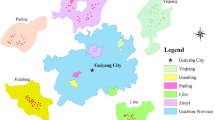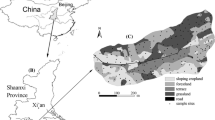Abstract
Soil organic carbon represents a major carbon pool in terrestrial ecosystems. Currently, in karst areas, there is considerable uncertainty regarding the estimation of soil organic carbon pools due to limited profile numbers and heterogeneity. Using a grid-based sampling method, 2755 soil profiles consisting of 22,057 soil samples were analyzed to determine the spatial distribution and storage of soil organic carbon (SOC) in the Houzhai River Basin in the Guizhou Province in southwest China. The results suggest that the total SOC storages in the 0–20 and 0–100 cm soil horizons of the Houzhai River Basin are approximately 2.65 × 108 and 5.39 × 108 kg C, respectively. The differences in the soil bulk density between different soil types were considerable. The average soil bulk density of large mud field loam, which ranged from 1.25 to 1.52 g/cm3, was significantly higher than that of the other soil types. The differences in soil organic carbon content were obvious as well. As soil depth increased, the organic carbon content gradually decreased. At a depth of 0–50 cm, the soil organic carbon content significantly decreased. In contrast, soil organic carbon content decreased slowly from 50 to 100 cm, indicating that a depth of 50 cm is the turning point for organic carbon content. The different degrees of soil organic carbon storage in different soil types were mainly caused by differences in organic carbon density. In karst regions, the soil parent material limits the spatial distribution of soil organic carbon, and soluble rock is the base development material. Soil thickness, slope gradient, and rock exposure are the primary factors leading to differences in SOC storage in different soil types. In addition, this study also suggests that increased attention should be paid to rock exposure in the assessment of SOC stocks in karst mountainous areas, such as the Houzhai River Basin.






Similar content being viewed by others
References
Adak T, Singha A, Kumar K, Shukla SK, Singh A, Singhkumar V (2014) Soil organic carbon, dehydrogenase activity, nutrient availability and leaf nutrient content as affected by organic and inorganic source of nutrient in mango orchard soil. J Soil Sci Plant Nutr 14:394–406
Akpa SIC, Odeh IOA, Bishop TFA, Hartemink AE, Amapu IY (2016) Total soil organic carbon and carbon sequestration potential in Nigeria. Geoderma 271:202–215
Bohn HL (1982) Estimate of organic carbon in world soils. Soil Sci Soc Am J 46:1118–1119
Chen XB, Zheng H, Zhang W, He XY, Li L, Wu JS, Huang DY, Su YR (2014) Effects of land cover on soil organic carbon stock in a karst landscape with discontinuous soil distribution. J Mt Sci 11:774–781
Fang F, Hu YK, Gong YM, Tang HP (2015) Soil organic carbon of different decomposition rate and its relation to microbial activity in saline-alkali desert ecosystem. Pol J Ecol 63:102–109
Fontaine S, Barot S, Barre P (2007) Stability of organic carbon in deep soil layers controlled by fresh carbon supply. Nature 450:277–280
Fox DM, Bryan RB (1999) The relationship of soil loss by in terrill erosion to slope gradient. CATENA 38:211–222
Fu G, Zhang XZ, Zhou YT, Yu CQ, Shen ZX (2014) Partitioning sources of ecosystem and soil respiration in an alpine meadow of Tibet Plateau using regression method. Pol J Ecol 62:17–24
Gong YM, Hu YK, Fang F, Liu YY, Li KH, Zhang GM (2012) Carbon storage and vertical distribution in three shrubland communities in Gurbantunggut Desert, Uygur Autonomous Region of Xinjiang, Northwest China. Chin Geogra 22:541–549
Grüneberg E, Schning I, Hessenmller D, Schulze ED, Weisser WW (2013) Organic layer and clay content control soil organic carbon stocks in density fractions of differently managed German beech forests. Forest Ecol Manag 303:1–10
Juan A, Roque O, Noelia GF, Antonio RN, Maria A, Javier GP, Maria MM (2013) Land use and climate change impacts on soil organic carbon stocks in semi-arid Spain. J Soils Sedim 13:265–277
Kinsey-Henderson AE, Wilkinson SN (2013) Evaluating Shuttle radar and interpolated DEMs for slope gradient and soil erosion estimation in low relief terrain. Environ Modell Softw 40:128–139
Koulouri M, Giourga C (2007) Land abandonment and slope gradient as key factors of soil erosion in Mediterranean terraced lands. CATENA 69:274–281
Lal R (2002) Soil carbon sequestration in china through agricultural intensification and restoration of degraded and desertified ecosystems. Land Degrad Dev 13:469–478
Nelson DW, Sommers LE (1982) Total carbon, organic carbon, and organic matter. In: Page AL, Miller RH, Keeney DR (eds) Methods of soil analysis, agronomy, part 2, 2nd edn. ASA and SSSA, Madison, pp 539–577
Niu X, Gao P, Li Y, Li X (2015) Impact of different afforestation systems on soil organic carbon distribution characteristics of limestone mountains. Pol J Environ Stud 24:2543–2552
Parrasalcántara L, Lozanogarcía B, Brevik EC, Cerdà A (2015) Soil organic carbon stocks assessment in Mediterranean natural areas: a comparison of entire soil profiles and soil control sections. J Environ Manag 155:219–228
Pouyat RV, Groffman PM, Yesilonis ID, Hernandez L (2002) Soil carbon pools and fluxes in urban ecosystems. Environ Pollut 116:107–118
Schlesinger WH (1982) Carbon storage in the caliche of arid soils a case study from arizona. Soil Sci 133:247–255
Wang YG, Li Y, Ye XH, Chu Y, Wang XP (2010) Profile storage of organic/inorganic carbon in soil: from forest to desert. Sci Total Environ 408:1925–1931. https://doi.org/10.1016/j.scitotenv.2010.01.015
Weissert LF, Salmond JA, Schwendenmann L (2016) Variability of soil organic carbon stocks and soil CO2 efflux across urban land use and soil cover types. Geoderma 271:80–90
Wu M, Liu SJ, Ye YY, Zhang W, Wang KL, Chen HS (2015) Spatial heterogeneity and storage assessment method of surface soil organic carbon in high bulk-rock ratio slopes of Karst Regions. Chin J Eco Agric 6:676–685 (in Chinese with English abstract)
Xu XF, Thornton PE, Post WM (2013) A global analysis of soil microbial biomass carbon, nitrogen and phosphorus in terrestrial ecosystems. Glob Ecol Biogeogr 22:737–749
Ying B, Xiao SZ, Xiong KN, Cheng QW, Luo JS (2012) Comparative studies of the distribution characteristics of rocky desertification and land use/land cover classes in typical areas of Guizhou province, China. Environ Earth Sci 71:631–645
Zhang ZM, Zhou YC, Wang SJ, Huang XF (2017) Estimation of soil organic carbon storage and its fractions in a small karst watershed. Acta Geochim 1:1–12
Zheng T, Wu XQ, Dai EF, Zhao D (2016) SOC storage and potential of grasslands from 2000 to 2012 in central and eastern Inner Mongolia, China. J Arid Land 8:364–374
Zhou YC, Wang SJ, Lu HM, Xie L, Xiao D (2010) Forest soil heterogeneity and soil sampling protocols on limestone outctops: example from SW China. Acta Carsol 39:115–122
Acknowledgements
This work was financially supported by the National Key Basic Research Development Program (Grant No. 2013CB956702), the Great Basic Research Fund of Guizhou Province (Grant No. QKH-JZ-2014-200203), the 100 High Level Innovating Project (Grant No. QKHRC-2015-4022) and Regional fund of the National Natural Science Foundation of China (Grant No. 41561075).
Author information
Authors and Affiliations
Corresponding author
Rights and permissions
About this article
Cite this article
Zhang, Z., Zhou, Y., Wang, S. et al. The soil organic carbon stock and its influencing factors in a mountainous karst basin in P. R. China. Carbonates Evaporites 34, 1031–1043 (2019). https://doi.org/10.1007/s13146-018-0432-3
Accepted:
Published:
Issue Date:
DOI: https://doi.org/10.1007/s13146-018-0432-3




